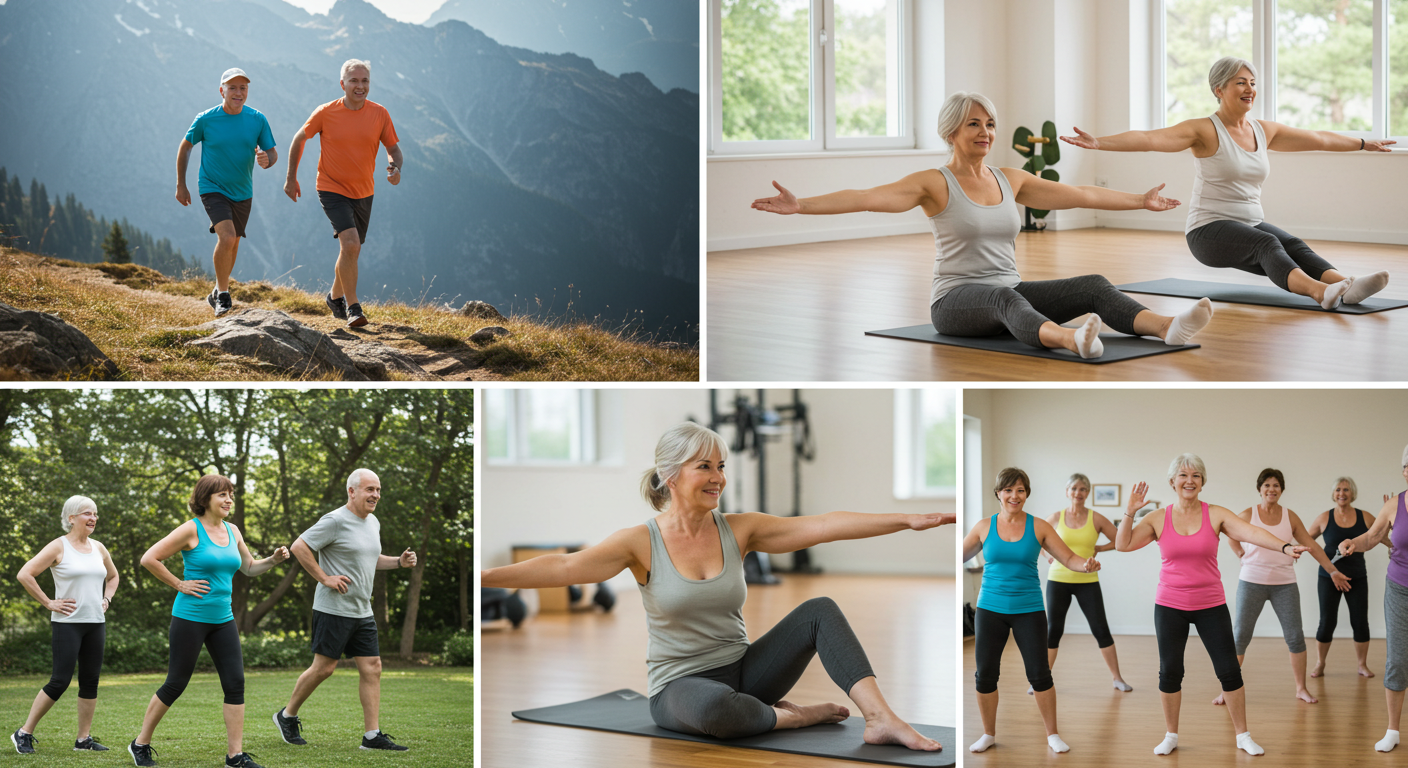
Physical activity is crucial for cancer prevention and overall health. The UK Biobank study used data from accelerometers to see how daily movement helps. It found a 26% lower risk of obesity-related cancers, showing the value of daily steps and light activity.
This article shows that total daily steps might be more important than how hard you exercise. It offers tips on adding more movement to your daily life. It proves that small changes can make a big difference in lowering cancer risks.
Key Takeaways
- Daily movement supports a 26% reduction in the chance of obesity-related cancers.
- The UK Biobank study provides valuable accelerometer data for better insights.
- Light physical activity can be just as beneficial as intense workouts.
- Small increases in daily steps may lead to long-term health advantages.
- Focusing on consistent physical activity can help with cancer prevention.
- Tracking steps gives a clear view of progress and boosts motivation.
The Power of Daily Movement in Reducing Cancer Risk
Daily movement greatly improves health. Experts from the American Cancer Society say moderate activity helps avoid weight issues. A brisk walk or light aerobics keeps body fat in check and boosts energy.
This not only strengthens immunity but also improves heart health. Active people often have better moods and overall well-being. It’s the small, consistent efforts that matter most.
Research shows a 26% risk reduction with regular movement. Taking breaks from sitting improves blood flow and lowers cancer risk. Swapping sedentary activities for simple tasks or walks can also reduce cancer risk factors associated with excess weight.
The Centers for Disease Control and Prevention found that small increases in daily steps make a big difference. Even short walks in the morning or after meals can help meet activity goals.
Public health recommendations suggest at least 150 minutes of exercise weekly. Doctors often advise lifestyle changes that include walking or cycling to work. Adopting a move more sit less lifestyle helps balance energy and fight obesity and cancer.
Using stairs, taking short breaks to stand, and doing home workouts are practical ways to stay active. These small changes reduce stress and strengthen bones and muscles.
Experts support evidence-based strategies for gradual fitness improvements. Each workout helps manage weight, improves mood, and protects against serious diseases. Light activity throughout the day fights harmful habits and chronic conditions.
Setting achievable goals boosts confidence and motivation. A consistent routine is key to a better outlook on life. This dedication fosters resilience and promotes a healthier community. Movement truly makes a difference.
Introduction to the UK Biobank Study
The UK Biobank is all about the health benefits of moving and fighting cancer. It uses data from over half a million people. This helps us see health trends in different communities.
Context and Background
This study looks at how much people move and compares it to health guidelines. It shows that exercise does more than just help with weight. It gives us clues about cancer too. The use of wearable devices makes the data more accurate.
Objective and Scope
Researchers want to link real-life data with health tech. They use devices to track fitness accurately. This helps them understand how to lower cancer risks linked to obesity.
Engaging Statistics on Risk Reduction
By studying how people move, scientists find out how important it is. They see that even a little more exercise can make a big difference. It helps lower disease rates and supports health for a long time.
Understanding the Accelerometer-Based Methodology
This method shows how each person’s steps and movements were tracked. Unlike old ways, it uses devices for exact data. This helps spot when someone is active or not.
The study used data from the uk biobank analysis. It found important facts for a healthy lifestyle. Small devices on wrists recorded daily activity, avoiding memory errors.
This study shows how tech helps track every step. It’s a big step towards better health.
Why Accelerometer Data Matters Over Self-Reporting
Objective data gives a true picture of activity. It shows when someone is moving or resting. This helps link activity to health outcomes.
It gives a clear view of how lifestyle affects cancer risks.
Wearable Devices Used in the Research
Advanced gadgets helped researchers see sitting and walking patterns. They analyzed each reading to find patterns. This led to insights on a balanced lifestyle.
Such findings help fight health risks from being inactive.
Strength in Numbers: The Study’s Large-Scale Credibility
Big organizations like cancer research uk say bigger samples are better for finding risks. This study used health data from over 85,000 people. It’s a big step towards finding ways to prevent diseases.
Having many people in the study makes the results more believable. It looked at how different lifestyles affect aging and cancer. By studying how people move, scientists found that being active helps fight diseases.
People from all walks of life took part in the study. This made the findings more reliable. It showed how small changes in our daily lives can make a big difference in our health.
Experts say big numbers mean less chance of error. This makes the study’s results more trustworthy. It helps doctors and leaders make better health plans.
The study gathered lots of data on how people live and how they feel. It found that regular exercise can really help prevent cancer. It shows that even small actions can make a big difference.
Big studies like this one help everyone agree on important health issues. They show that staying active is key to a healthy life. This message is for everyone.
Learning from such a big project shows the power of working together in health research. Every person’s input helps create better health guidelines. These findings encourage us to live healthier, more active lives.
Gathering Data Through Wearable Devices
Researchers wanted to understand how daily movement affects health. Wearable sensors gave them exact data. This helped guide research on preventing cancer, moving away from guesses.
Recruitment of Over 85,000 Participants
Thousands of volunteers joined a study on cancer prevention. This big group allowed for deep research into lifestyle choices. Each person wore an accelerometer to track their daily activities.
Researchers used this data to see how small actions affect cancer risk. They found that even small steps can make a big difference.
Tracking Steps, Light, and Moderate Activity
Wearable devices tracked steps and how hard people moved. They recorded light activities and more intense ones. This showed that big workouts aren’t always needed.
Even small actions, like walking more, help build healthy habits. These findings suggest that adding simple activities to our day can lead to a healthier life and lower cancer risk.
How Researchers Measured and Analyzed Physical Activity
Researchers gathered detailed data on daily movement to show how exercise helps prevent cancer. They looked at each person’s step count and how hard they were walking.

They split total steps into light and moderate ranges to find links with obesity-related cancers. This showed that even small movements help fight inflammation and improve insulin sensitivity. It also helps prevent cancer in different groups of people.
Defining Total Daily Steps
They set up clear rules for daily walking to find connections with hormone regulation. Each person’s activity showed how often they walked. This showed the importance of regular movement.
Examining Light vs. Moderate Exercise
Researchers found different levels of effort that help with DNA repair. Light walks and short bursts of fast walking were among the best. Each level helps the body’s defenses.
These findings showed the value of precise data from accelerometers. They gave a clear picture of consistent habits. The team mapped out activity levels that help prevent cancer.
Participants tracked their steps for a week. This confirmed patterns that surveys might miss. It gave a reliable way to see how pace affects well-being.
In real-world settings, the team found new insights on movement and cancer risk. Each step gave important evidence for better health advice.
This careful analysis shows how exercise boosts natural defenses. By looking at different intensities, researchers found unique benefits. It reminds us that every step is important for our health.
Spotlight on the 26% Cancer Risk Reduction
Daily steps can play a major role in lowering cancer risk. Studies show a 26% drop in incidence when consistent movement becomes part of everyday life. This finding prompts many to ask: does walking prevent cancer? Experts suggest brisk walks make a big difference.
Seniors who follow cancer prevention workouts for seniors often see improvements in overall health. Others who embrace exercise routines for cancer survivors report renewed energy, stronger immunity, and improved confidence.
Research points to physical activity guidelines for cancer risk as valuable advice for all ages. Questions about how much exercise reduces cancer risk continue to arise, yet any amount of routine activity appears beneficial. Adding gentle walking to women’s cancer prevention exercise plans is a smart choice when aiming for long-term wellness.
There is evidence that these exercises protect against many forms of the disease, including breast cancer. In fact, exercise protects against breast cancer by helping regulate body weight and hormone balance.
Varied activities, from moderate walks to strength-based sessions, can cut the odds of developing serious illness. Those wondering can strength training lower cancer risk will find that muscle-building plans help reduce excess fat linked to disease. Light jogging or aerobics also emerge as the best exercise for cancer prevention when paired with balanced nutrition.
Findings suggest that targeted workouts bolster health and ward off multiple types of cancer, turning simple movement into a powerful shield.
Cancer prevention, physical activity, UK Biobank study, accelerometer data
Experts have found a strong link between moving more and getting less cancer. The uk biobank study showed that using accelerometer data can help adults fight cancer. Doctors say taking more steps each day can help prevent cancer.

One big study found that people who exercised saw a 26% lower risk of cancer. This was true for both intense workouts and gentle activities. A review of studies confirmed that exercise is good for the gut and can lower cancer risk.
Researchers found that active people had a much lower risk of cancer than inactive ones. Even light activity offered some protection. This shows that moving more can help prevent cancer.
Connecting Movement Intensity to Reduced Cancer Risk
New studies show that how fast and often you move matters. Quick, intense activities can fight off harmful inflammation. Steady, slow activities keep your body’s defenses up.
Further Implications for Obesity-Related Cancers
Being overweight can make you more likely to get cancer. Regular exercise helps burn fat and keep your metabolism balanced. This combo lowers the risk of cancers linked to obesity.
Studies show that staying active improves:
- Improved immune function
- Better weight control
- Stronger cardiovascular endurance
These benefits help fight cancer by controlling hormones and reducing stress in the body. The key is to move regularly, not just in intense bursts.
People who make small changes to their daily routine, like walking faster or stretching, see big health benefits. This mix of purposeful activity strengthens both body and mind, offering strong protection against cancer.
Turning Data into Action: Easy Ways to Move More
Starting to start exercising to prevent cancer is easy. Just add more steps to your day. Every minute of movement helps fight long periods of sitting. Setting small goals, like a short walk, can motivate you.
These actions help with lung cancer prevention in smokers and boost your health.
Being active at work is easy too. Try brief stretches or “walking meetings.” These activities follow endometrial cancer exercise guidelines and build strong habits. Even small changes, like taking the stairs, can become a habit.
Practical Lifestyle Changes and Public Health Recommendations
Experts suggest walks, yoga, and other colon cancer prevention workouts to stay active. You can break up 30-minute exercise cancer prevention goals into shorter times. These steps also help with bladder cancer risk physical activity and keeping a healthy weight.
How to “Move More and Sit Less” in Everyday Routines
Experts suggest light routines for exercise to prevent breast cancer. Try easy stretches at home or outside. A little sunshine and stretching can make a big difference in small changes to reduce cancer risk.
Tracking Progress and Staying Consistent
Keeping a journal or using health apps can help you reach your goals. Over time, colon cancer prevention workouts and other activities become second nature. The key is to stay consistent with a balanced plan that supports your health.
Conclusion
Every day, we can take steps to fight cancer by moving more and sitting less. Studies from the UK Biobank show that regular exercise helps protect against cancer. Using wearable fitness trackers can help us track our progress and stay motivated.
Adding variety to our workouts, like HIIT, can be beneficial. But even simple activities throughout the day can help. Research shows that small efforts can make a big difference. Health experts now recommend personalized exercise plans to meet individual needs.
Looking for exercise programs near you? Check out local gyms or community centers. The World Health Organization suggests daily steps as a key to good health. Free workout plans are available from local nonprofits and the American Cancer Society.
Joining community exercise classes can also help. These classes offer support and motivation. Government guidelines encourage us to set achievable goals and move more for better health.
